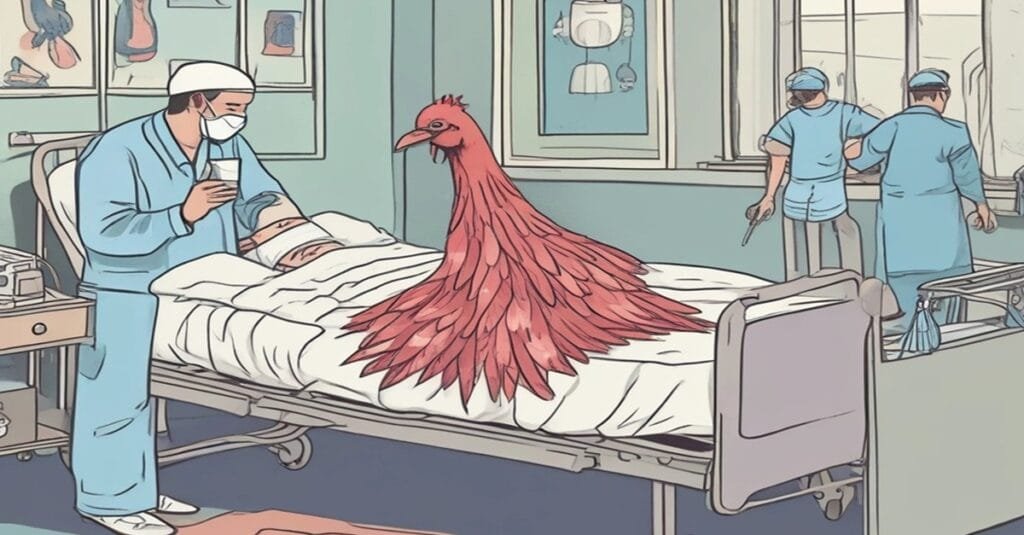What is Bird Flu?
Bird flu, scientifically known as avian influenza, refers to a group of viral infections that primarily affect birds but can also impact humans and other animals. The virus exists in different strains, which vary in virulence and susceptibility. Among these strains, H5N1 and H7N9 are the most notable for their potential to cause severe disease not only in avian populations but also in humans. These subtypes are classified as high-pathogenic avian influenza (HPAI) due to their severe effects on poultry health, often leading to substantial mortality rates.
The transmission of avian influenza occurs primarily through direct contact with infected birds, their droppings, or contaminated environments. Wild birds, particularly waterfowl, are natural hosts of the virus and often do not show symptoms, allowing them to spread the virus to domestic birds and mammals without immediate detection. Once the virus enters a commercial poultry flock, it can spread rapidly, leading to large-scale outbreaks, which have significant economic implications for the poultry industry.
In terms of human infection, the risk is relatively low, but it is critical to recognize the potential for zoonotic transmission. Human cases usually arise from close contact with infected birds, and while the majority of cases have resulted in severe illness, the overall number of human infections remains limited compared to seasonal influenza. Despite this, health authorities continuously monitor these viruses, as mutations can lead to new strains capable of efficient human-to-human transmission, posing an imminent public health threat.
Understanding the dynamics of bird flu is crucial, especially in light of recent outbreaks in the United States. Monitoring, control measures, and vaccinations are pivotal in mitigating the impact of avian influenza on both bird populations and public health.
Do you know how to get rid of a stubborn cold Read our post to get rid of it.

Historical Context of Bird Flu Outbreaks
The history of bird flu outbreaks is marked by several significant events that have shaped our understanding and management of this avian disease. The H5N1 strain emerged in the late 1990s and rapidly spread through domestic and wild bird populations across Asia, resulting in mortality among poultry and occasional human cases. The global response to the H5N1 crisis led to improved biosecurity measures and enhanced surveillance systems, particularly in poultry industries. Health authorities realized the importance of early detection and rapid response, which have proven effective in mitigating potential pandemics.
Another notable outbreak occurred in 2013 when the H7N9 virus emerged in China. This strain raised concerns due to its ability to infect humans with potential for severe illness. The prompt identification of cases and swift public health interventions were critical in containing its spread. The global health community learned that strong collaboration among nations is vital in addressing zoonotic diseases like bird flu. International reporting systems and sharing of information became key components in the fight against these outbreaks.
In 2015, the United States faced a significant outbreak of H5N2 avian influenza, which devastated poultry farms across several states. The outbreak necessitated the culling of millions of birds to stop transmission. Health authorities analyzed the effectiveness of response strategies employed during this crisis. The rapid response and implementation of strict biosecurity protocols were essential in limiting the outbreak’s duration and impact. These historical episodes serve as important cases that inform current approaches to managing bird flu outbreaks. By reflecting on past experiences, health officials can better prepare for future occurrences, ensuring a more resilient system against these avian influenza threats.
Read the benefits of streptococcus thermophilus
The December 2024 Outbreak in the United States
In December 2024, the United States witnessed a significant outbreak of avian influenza, commonly referred to as bird flu. The outbreak was predominantly concentrated in the Midwest region, with states such as Iowa, Minnesota, and Wisconsin being heavily affected. These areas have previously been documented for their large poultry populations, making them particularly susceptible to the disease. The Centers for Disease Control and Prevention (CDC) and the United States Department of Agriculture (USDA) confirmed the presence of the H5N1 strain, which has raised concerns due to its potential impact on both avian and human health.
As of mid-December, reports indicated that over 20 million domestic birds had been affected, necessitating a series of containment measures and culling operations. The immediate response from local and federal authorities involved heightened surveillance around identified hot spots, routine testing, and enhanced biosecurity protocols on poultry farms. Farmers were urged to implement strict measures to mitigate the risk of transmission, such as limiting farm access, utilizing protective gear, and ensuring disinfection of equipment and vehicles entering and leaving the premises.
Statistics provided by the USDA highlighted a steep increase in reported cases compared to previous months in 2024. The agency noted a 300% rise in confirmed infections within avian populations since November, underscoring the urgency for rapid intervention. To combat the spread, vaccination campaigns have also been initiated for poultry in affected areas, with emphasis on both prevention and education regarding the disease. By early January 2025, further assessments will be conducted to evaluate the effectiveness of these mitigation strategies and to monitor the situation closely, ensuring the protection of both agriculture and public health.
Impact on Poultry Industry
The recent outbreak of bird flu in the United States has significantly affected the poultry industry, leading to widespread economic and operational challenges. As farmers and businesses grapple with the disease, losses have mounted, disrupting the supply chain that is critical to delivering poultry products to consumers.
In terms of economic consequences, the outbreak has resulted in substantial financial impacts. Farmers have incurred losses not only from the culling of infected birds but also from a decrease in overall production capacity. For many, this means a potential long-term decline in income and market share as they attempt to recover from such a devastating event. Some estimates suggest that the economic toll could reach into the billions, affecting not only the farmers directly involved but also suppliers, processors, and retailers reliant on a stable poultry supply.
The outbreak has further strained supply chains, prompting many businesses to scramble to secure alternative sources of poultry. With heightened demand and diminished supply, prices for poultry products have surged, impacting consumers and businesses alike. This disruption underscores the fragility of the poultry supply chain, calling into question the industry’s resilience to future outbreaks.
In response to this crisis, regulatory measures have been implemented to safeguard the poultry industry and maintain food safety. The USDA has initiated strict biosecurity protocols to mitigate the spread of the virus, ensuring that farms adhere to rigorous sanitation practices. Additionally, vaccination programs are being explored as a possible long-term solution to protect avian populations from future outbreaks.
The combined effect of these measures aims to stabilize the industry, ensuring that the poultry supply can meet consumer demand while addressing the immediate threat posed by bird flu. Farmers, businesses, and regulators must remain vigilant to navigate the complexities of this outbreak and secure the future of the poultry industry in the United States.
Public Health Implications
The recent outbreak of bird flu in the United States has raised considerable concerns regarding public health. Bird flu, particularly the highly pathogenic avian influenza (HPAI) strains, primarily affects birds but also poses a potential risk to human health, especially for those who interact closely with infected poultry. Transmission to humans typically occurs through direct or indirect contact with infected birds, their droppings, and contaminated environments. As such, individuals working in the poultry industry or those residing near affected avian populations should be vigilant about the potential for exposure.
Risk factors for acquiring bird flu vary but are notably increased among specific groups, such as poultry workers, veterinarians, and animal handlers. Symptoms in humans can range from mild respiratory issues to severe pneumonia and, in extreme cases, can lead to death. To mitigate the risks associated with this outbreak, health authorities recommend a series of precautions aimed at reducing transmission probability. These precautions include practicing good hygiene, wearing appropriate protective gear when handling birds, and ensuring that food products are fully cooked.
Current research initiatives focus on understanding the mechanisms of bird flu transmission to humans better and monitoring the genetic mutations in avian strains that might enhance transmissibility. Public health agencies are actively investigating the outbreak’s scope while emphasizing the importance of surveillance and rapid response to contain any potential spread. Additionally, guidelines issued by health authorities underscore the importance of vaccination for poultry against bird flu to limit outbreaks and protect both animal and human health.
As the situation evolves, ongoing vigilance and adherence to public health recommendations remain pivotal in addressing the implications of the bird flu outbreak and safeguarding communities across the nation.
Recent Research and Developments
In recent months, significant strides have been made in understanding and combating avian influenza, commonly known as bird flu, particularly in light of the outbreaks observed across the United States. Researchers are focusing not only on vaccination efforts for poultry but also on the development of enhanced treatment options for infected birds. Studies have evidenced that the efficacy of existing vaccines can be improved through the introduction of modified live-virus strains, which may lead to broader immunity within flocks. This advancement is crucial as it pertains to minimizing the transmission of the virus among domestic and wild bird populations.
Moreover, ongoing research is being directed towards identifying more effective therapeutic agents for infected birds. Scientists are exploring novel antiviral drugs that could reduce morbidity and mortality rates in affected avian species. Their efforts aim to provide immediate relief to the birds while working towards longer-term preventive strategies. The progress in treatment is complemented by the application of biotechnology, which allows for quicker diagnostics to isolate and respond to infections, thus curbing the spread of the disease more effectively.
Emerging technologies play an indispensable role in preventing outbreaks of bird flu. Innovations in bioinformatics and predictive modeling are enabling researchers to better understand the genetic evolution of the virus and its zoonotic potential. Collaboration at both national and international levels has become more pronounced, with various countries sharing surveillance data and research findings. This cooperation is vital in developing a global response to avian influenza, fostering a network that allows for quick action against potential outbreaks. In light of these recent research and developments, it is evident that a united approach is essential for effective management of bird flu and protecting avian health on a global scale.
Looking Ahead: Preventive Measures and Recommendations
The recent outbreak of bird flu in the United States has highlighted the necessity for proactive measures to prevent future incidents. Both the poultry industry and the general public play crucial roles in mitigating the risks associated with avian influenza. One of the foremost strategies recommended for poultry farms is the implementation of stringent biosecurity practices. These measures should include restricting access to farm premises, regularly sanitizing equipment, and controlling the movement of birds. Additionally, farmers should maintain a thorough health monitoring program for their flocks, allowing for prompt diagnosis and treatment of any illness.
Public awareness campaigns are equally essential to educate communities about the risks of bird flu and safe practices to follow. Informing the public about the signs of infection in both birds and humans can help in early detection and response. Awareness initiatives should also encourage responsible handling and consumption of poultry products. It is vital for consumers to remain informed about food safety measures, which can significantly reduce the likelihood of viral transmission.
Ongoing surveillance and preparedness plans established by government agencies are critical components in the fight against future outbreaks. Systems must be in place for timely reporting and tracking of avian influenza cases among poultry populations. Regular inspections and testing protocols should be reinforced to ensure rapid response capabilities. Collaboration between public health authorities, veterinarians, and poultry producers can enhance the overall resilience of the industry against potential threats.
In conclusion, a multifaceted approach involving biosecurity practices, public education, and governmental oversight is essential to limit the impact of bird flu outbreaks. These preventive measures will contribute to safeguarding both the poultry industry and public health, ensuring a more secure future.
See YouTube video about Bird Flu.
How to get rid of your COLD fast!
HeLa: 7 Incredible Lessons from Henrietta Lacks’ Legacy That Changed Science Forever




